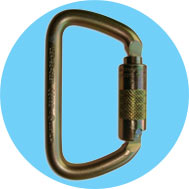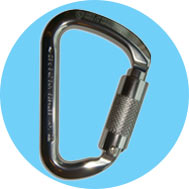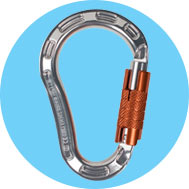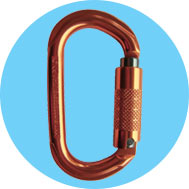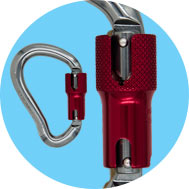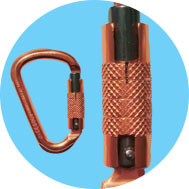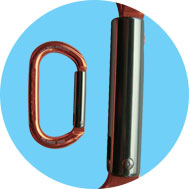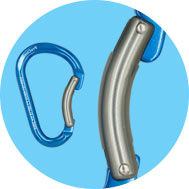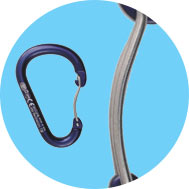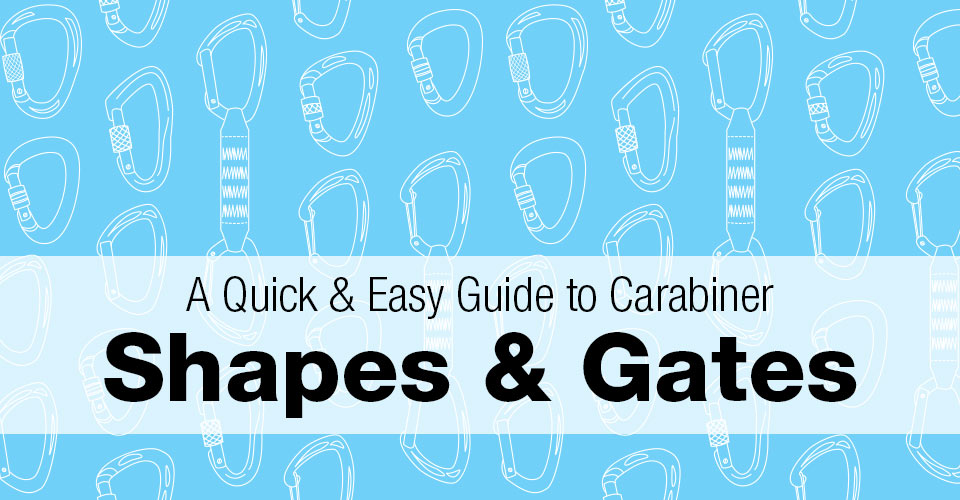
Carabiners are one of the many types of connectors used in the professional climbing industry and are one of the most popular due to their varying shapes and sizes. Once you understand and have assessed the differences between carabiners, think about your climbing needs since different applications will require different kinds of carabiners. To start, two main variations you should consider are shape and gate type.
Carabiner Shape
'Biners come in a variety of shapes including HMS, Klettersteig, captive eye and even brand specific such as Kong Italy's Ferrata and Ergo or Omega Pacific's Five-O shape. For now, let's discuss some of the more common carabiner shapes:
D-Shape Carabiner
Also known as equal-D, this is one of the most popular carabiner shapes for almost any type of climbing application. D-shaped carabiners are designed to reduce weight from the center gate and toward the non-gated side. A smaller, and lighter D-shape carabiner can be just as durable as an oval carabiner.
Pros:
- Durable shape
- Available in a variety of gate options (e.g. twist lock, screw lock, double/triple action lock, straight, bent)
Cons:
- Gate opening is relatively smaller than modified D shape
- More expensive than oval shape
Modified D-Shape Carabiner
Sometimes called asymmetric D shape carabiners or offset D, modified D carabiners are another one of the most popular designs as the majority of climbers own and use them in a variety of climbing applications. Mod D carabiners get their name because they work like regular D shape carabiners, except they are slightly smaller at one end to reduce weight. They usually have larger gate openings, which makes it easier to clip them on. The only downside is they do not have much room inside, compared to regular sized D’s or oval carabiners.
Pros:
- Large gate opening
- Strong and lightweight
- Easy to clip on
- Available in a variety of gate options (e.g. twist lock, screw lock, double/triple action lock, straight, bent)
Cons:
- Not as strong as regular D shape
- Some are more expensive than others
Pear Shape Carabiner
Very much alike to the modified D shape, pear-shaped carabiners have large gate openings to allow easy clipping of rope and gear. This type is usually used primarily for belaying and rappelling, but can also serve as an anchor point to top roping or multi-pitch climbing.You will sometimes see these pear-shaped carabiners marked as HMS carabiners, indicating that the carabiner is designed with a wide, more balanced top that fits well with a Munter hitch.
Pros:
- Large gate opening
- Made specific for belaying and rappelling
- Twist, screw, double/triple action lock, straight or bent gate options available
Cons:
- Heavier than most other carabiner shapes
- Not as strong as regular and modified D carabiners
Oval Shape
Oval shaped carabiners are the original style of carabiner and are more versatile, but not quite as strong as other shapes. The smooth, uniform top and bottom curves are designed to limit load shifting. They offer additional gear-holding capabilities than other D shape carabiners and their symmetry permits them to be used for carabiner-brake rappels. Since they center most of the weight load towards the center of the curve, this aids climbers to not shift under the load.
Pros:
- Shape limits load shifting
- Hold more gear than D-shape carabiners
- Available in a variety of gate options (e.g. twist lock, screw lock, double/triple action lock, straight, bent)
Cons:
- Smaller gate opening and relatively heavier than other shapes
- Not as durable as other shapes
Carabiner Gate Types: Locking vs. Non-Locking
Locking Gate Carabiner
Locking gate carabiners are designed to be locked in a closed position to provide extra protection against accidental gate openings. There are two common types of locking gates:
Screw Lock Gate
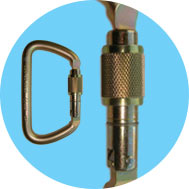 Screw lock gates require you to manually screw the sleeve onto the gate to lock it, and can be operated with one hand.
Screw lock gates require you to manually screw the sleeve onto the gate to lock it, and can be operated with one hand.
Pros:
- Manual sleeve lock
- Can be operated with one hand
- Reliable in dirty/harsh settings
Cons:
- The amount of time it takes to lock/unlock the sleeve
- Rubbing/vibrations can unlock the sleeve
- Risk forgetting to lock the sleeve
Twist Lock Gate
Also known as a double-action locking gate, the twist lock gate carabiner requires two motions of opening and closing the carabiner. The two motions consist of manually twisting and pulling inward, and once released, the gate automatically locks when the gate is closed.
Pros:
- Auto-lock gate
- Speed and ease of opening
- Rapid auto-locking
Cons:
- Sleeve must be unlocked each time the carabiner is opened
- Not as secure as a triple lock.
Triple Lock Gate
Triple-action locking gates require three distinct motions to open the gate which will cause the carabiner to auto-lock itself when the gate is released. The three motions consist of pushing the carabiner sleeve up or down, twisting the sleeve, and finally, pulling the gate inward.
Pros:
- Rapid auto-locking gate
- Three motions for more rope security
Cons:
- Sleeve must be unlocked each time the carabiner is opened
- Two hands needed to insert a device into the carabiner
- Sensitive to mud or other foreign objects that can impede with auto-locking mechanism
Non-Locking
Please note that a non-locking gate should NEVER be used in climbing applications where fall protection or human support is its main function. Non-locking gate carabiners should only be used to support gear and not people.
Straight Gate
As the name implies, straight gate carabiners are straight from top to bottom, and are commonly used for a variety of non-climbing applications. They are mainly found on quickdraws and are frequently used for racking gear, such as stoppers and cams. Straight gate 'biners are designed to open easily when pushed, and close automatically when released, thanks to their spring-loaded design. Some straight gates also feature a keylock nose mechanism that keep the carabiner from hooking and catching on your harness gear loop for snag-free climbing.
Bent Gate
Bent gate carabiners are usually reserved for the rope-end of quickdraws; this makes clipping a rope quick & easy because of their strong, durable and concave shaped gate opening.
Similar to straight gate carabiners, some bent gate carabiners feature a keylock mechanism and typically have an asymmetrical shape.
Wire Gate
Wire gate carabiners feature a stainless steel wire loop for a gate, decreasing the overall weight and eliminating the need for excess parts found in common gate types. The wire gate design allow for a larger gate opening and is also less likely to freeze compared to other gate styles in cold temperatures.
Some wire gates don’t appear to be as strong as other common styles, but indeed they are due to their lower mass in the gate itself, which are less likely to vibrate during a fall.
At U.S. Rigging Supply, we offer a complete range of professional fall protection carabiners. Certified ANSI Z359 steel carabiners, lighter aluminum ANSI carabiners and NFPA 1983-G & T rated rescue carabiners are also available. All carabiner shapes and gate styles mentioned in this post are available on our site too. Looking for something low or high-strength? We have a wide variety of carabiners ranging all the way up to 60kN (that’s over 13,000 lbs!).



